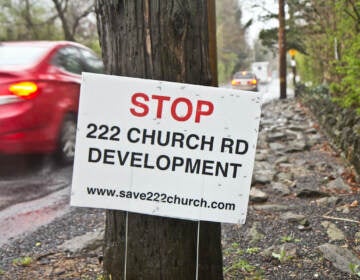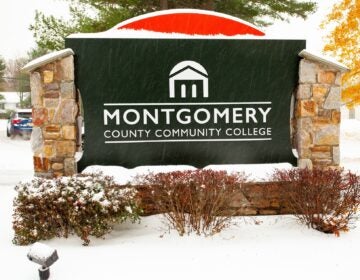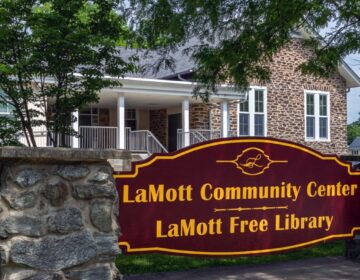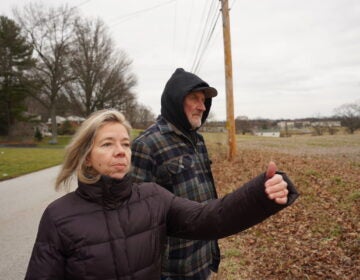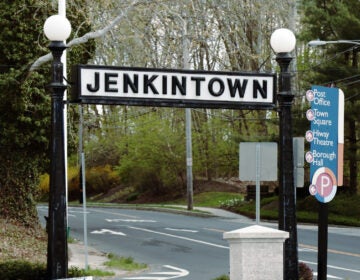‘The thin blue line has divided us:’ the Police Benevolent Association logo unearths conflict in Montgomery County township
Springfield Township residents are divided over the Police Benevolent Association’s use of the ‘Blue Lives Matter’ flag in its logo.
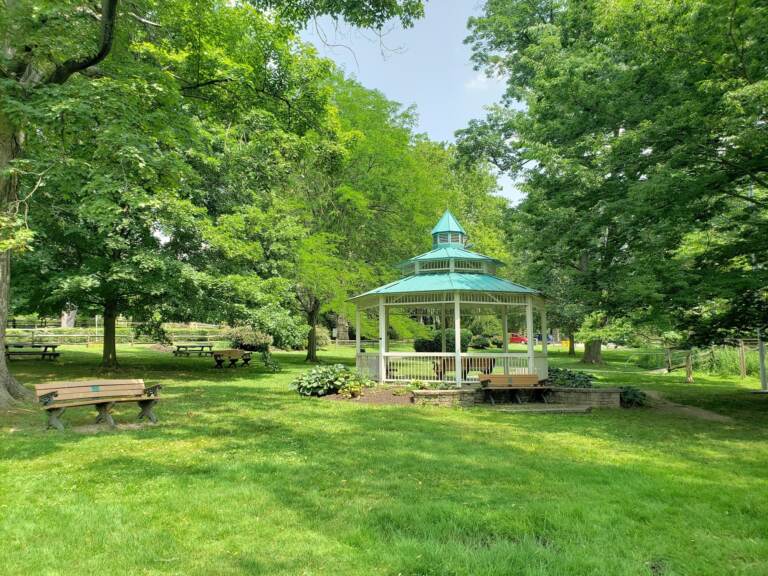
The gazebo at James A. Cisco Park in Springfield Township, Delaware County. (Springfield Township)
Got a question about life in Philly’s suburbs? Our suburban reporters want to hear from you! Ask us a question or send an idea for a story you think we should cover.
Springfield Township residents are divided over the Police Benevolent Association’s use of the ‘Blue Lives Matter’ flag in its logo.
The debate came to a head during the Springfield Township commissioner’s meeting on Wednesday, April 13. Montgomery County residents and commissioners dueled, disagreeing over the use of the logo and its meaning.

Many residents, including representatives from NAACP Cheltenham Branch, say the flag provokes fear and distrust of the police and is associated with white supremacy, while others in support said it is a symbol of solidarity with police officers working in a dangerous field. Some disapproved of the use of the logo but said the PBA, which is a private entity, has the freedom to use it.
Some residents suggested that commissioners were not fit to lead the township because of their opposition to the PBA symbol, and suggested that the NAACP, which represents multiple municipalities including Springfield, was inciting division.
“It’s really an issue about how we handle incendiary, potentially inflammatory symbology and such, when it represents our township,” said Commissioner Susanna Ratsavong during the council meeting. “Sometimes good intentions have potentially more detrimental impacts than we expect or know.”
Board president and president of the Cheltenham NAACP Eddie Graham told WHYY that the intent of the meeting was to stir dialogue and “to hopefully get the majority of the community to realize what this means to the 8.5% African-American community here in Springfield Township.”
Instead, he said, “It showed how much more work we have to do here in the community.”
The Police Benevolent Association logo has been popping up across Springfield Township over the past year, bringing resident and township official opposition along with it.
PBA hung its banner on Willowgrove Avenue in Wyndmoor in October 2021 for its annual car show. The logo also flew on the little league baseball field, but was taken down after residents voiced concern. It also appeared on PBA regalia handed out during the township’s ‘Community Day’ in October 2021. About three weeks ago, the logo landed in residents’ mailboxes on PBA flyers.
Commissioners Graham, Ratsavong, and James Lee said they met with PBA president Christian Wilbur in October to discuss changing the logo. But the PBA unanimously voted against changing it. The township then offered the PBA $10,000 to subsidize the creation of a new logo.
There is a fraught history of the thin blue line on the American flag. It has been flown by white supremacists, appearing next to Confederate flags at the 2017 ‘Unite the Right’ rally in Charlottesville, Virginia, and at the January 2020 capitol insurrection. While the symbol has had a long stint in the United States, it reappeared as the Blue Lives Matter movement, which adopted the thin blue line flag, grew in response to the Black Lives Matter movement in 2014.
The PBA did not respond to WHYY’s request for comment.
“What have I missed?”
Most who expressed concern over the symbol also emphasized their respect for the Springfield police.
“We all want to support the police, and the symbol is making it difficult,” said Liza Meiris, Cheltenham NAACP secretary.
But Meiris wants the PBA to be held accountable. She said changing their logo is one step among many other steps towards larger change in Springfield.
What tensions lie under the surface of the PBA logo dispute?
According to a 2019 survey conducted by Springfield residents and researchers, while the majority of residents feel safe and positive towards the police, there are racial discrepancies in levels of safety and trust of police. Black residents are less likely to call the police and report less positive interactions with police than white residents. The surveyors received multiple stories regarding racial bias and policing in Springfield.
For Laura Viddy Darga, Springfield resident and parent, questions have risen now that the PBA has heard from the community about the symbol’s impact and has stood by their decision.
“At this point, I’ll say it’s willful insensitivity to a large segment of the community,” said Darga.
“It makes you think. ‘Well, what have I missed?’”
Darga, who is biracial, said she has only had positive interactions with the police and doesn’t believe the symbol represents who they are. The whole situation, she said, makes her sad.
“If people are telling you, ‘this makes me feel unsafe and this makes me uncomfortable,’ Why would you not heed that at all? Work through a compromise. Why are you dying on this hill? I don’t understand why they want to erode the trust of the community for this,” Darga said.
“It seems as if a thin blue line has divided us,” said Lauren Camper, a parent leader of Springfield’s Multicultural Parents Association.
“When I see that emblem, it scares me,” said Camper, who is African American.
She said she also has respect for her local police. It’s a small town, people are interconnected, she explained, she sees the risks of the job.
But she said Springfield police do not lie outside the larger institution of policing and the national reckoning around police and racial violence.
“For residents to say, ‘our Springfield police are top notch and they’re perfect,’ that’s simply not true either,” said Camper. “And it’s just disheartening that they can’t see or empathize or even understand that some of their fellow residents have had different experiences.”
Camper said some Black residents did not complete the 2019 anonymous survey out of fear of retaliation.
“They felt that they would still be found out and they would be targeted. What does that really say about this community?”
Camper’s family has had negative experiences with the Springfield police.
In December 2020, her 15-year-old son was knocking on his friend’s window in the middle of the night when the cops were called on him. The family who called didn’t know who was knocking, at the time.
Instead of bringing him home, Springfield Police brought him to the police station and wanted to refer him to the YAP program, a Youth Aid Panel, according to Camper. Montgomery County says completion of the YAP program will expunge a juvenile’s criminal record.
“Only problem is, my son wouldn’t have had a record because he didn’t commit a crime,” Camper said. “They told me I had to sign paperwork, and if I didn’t sign it, charges could be pressed.”
After Camper threatened the police department with litigation, they dropped it.
“I felt that they were trying to make an example out of my family because I’ve been vocal about criticizing the police,” she said.
She wants her neighbors to understand how she and her family navigate the world because of their skin color.
For instance, the advice she gives to her children: “Don’t wear your hood up. Don’t run. Don’t talk to the police the way your friend may talk to the police.”
Camper isn’t optimistic that PBA will change their decision.
But she is hopeful that the community can find commonalities through the chaos.
“Even though we have differences, we can always find one thing we agree on,” she said. “And when we find that one thing, you build upon that.”
The Cheltenham NAACP is holding a conversation on the thin blue line symbol at their next meeting on Monday, April 18.
WHYY is your source for fact-based, in-depth journalism and information. As a nonprofit organization, we rely on financial support from readers like you. Please give today.


